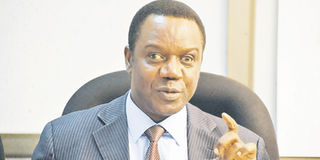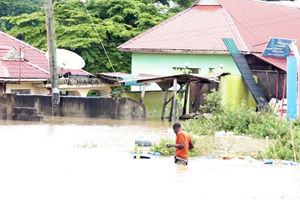8 small investors generate 30MW

The director general of the Energy and Water Utilities Regulatory Authority, Mr Felix Ngamlagosi, speaks at a past event. PHOTO|FILE
What you need to know:
The projects are in eight districts. The investors, with generated megawatts in brackets, are Tanganyika Plantation Company (20) in Kilimanjaro; Tanganyika Wattle Company (1.5) in Coast, Tulila Hydro-power (5) in Ruvuma, Iyovi Hydro-power (0.95) in Morogoro, Andoya Hydro-power (0.5) in Ruvuma, Darakuta Hydro-power (0.32) in Manyara and Mwenga Hydro-power plant (4) in Iringa
Dar es Salaam. Eight small-scale power projects (SPPs) have begun producing a total of 33.3MW in rural areas.
The projects are in eight districts. The investors, with generated megawatts in brackets, are Tanganyika Plantation Company (20) in Kilimanjaro; Tanganyika Wattle Company (1.5) in Coast, Tulila Hydro-power (5) in Ruvuma, Iyovi Hydro-power (0.95) in Morogoro, Andoya Hydro-power (0.5) in Ruvuma, Darakuta Hydro-power (0.32) in Manyara and Mwenga Hydro-power plant (4) in Iringa.
The director general of the Energy and Water Regulatory Authority (Ewura), Mr Felix Ngamlagosi, says since the regulator has simplified the process of approving SPPs, interest in venturing in small projects to generate electricity even in remote areas has risen.
Of the eight SPP investors, only one, at Mwenga, is being operated by a foreigner.
“Apart from the eight SPP energy ventures, which are in active operation, other 20 SPP investors await approvals. The majority of them are Tanzanians.”
According to him, investors are now able to just download the model power purchase agreement on the technology that they intend to use and that is a starting point for negotiations with the utility that they sign the power/energy sale contract with.
The Tanzania Electric Supply Company deputy director of investments, Mr Declan Mhaiki, recently told Norwegian energy business executives that more investors are highly needed to cope with the rising demand for power. According to him, while the current electricity production capacity is 1,357 MW, the country has set a target of producing 5,000MW by 2020 and 10,000MW by 2025.
That will be undertaken under the National Power Master Plan that envisages industrialising Tanzania.
“We have ample energy sources. Apart from the renewable sources such as biomass, wind, solar and geothermal, we have natural gas amounting 57.6 trillion cubic Feet, coal reserves and hydro-electric power potentials,” Mr Mhaiki.
The Rural Energy Agency acting director general, Mr Boniface Nyamo-hanga said the government had put in place guidelines for investors for rural electrification.
He says since the government plans to electrify all villages by 2020, more investors are called upon to embark on mini-grid projects.




